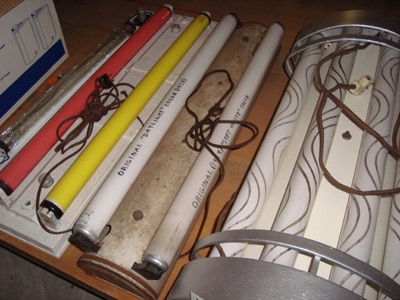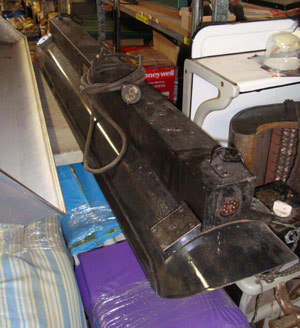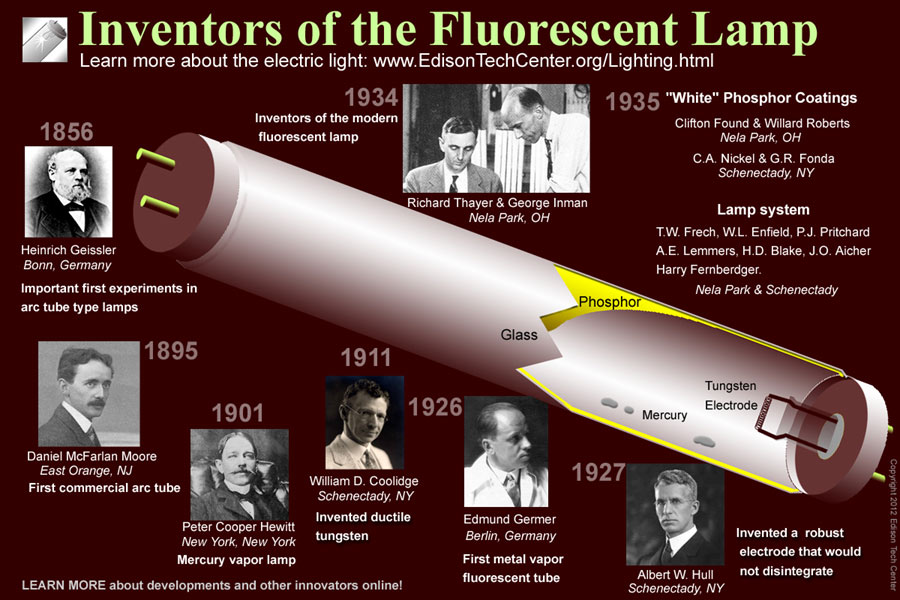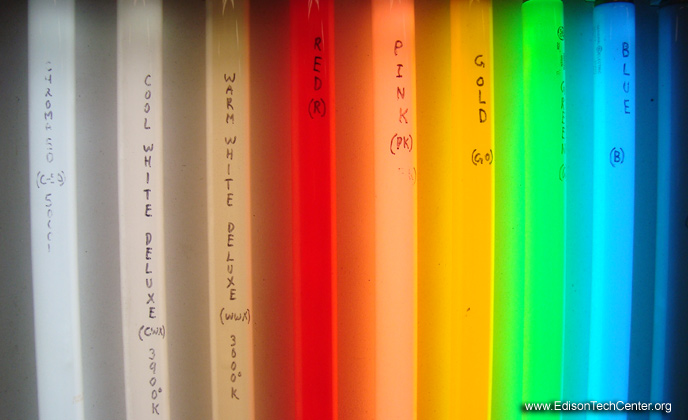
|
Disclaimer: The works below are the opinion of the author and not the official viewpoint of the Edison Tech Center:
Fluorescent Lamp Development:
A comprehensive history covering the 1930s and 1940s by Rick DeLair
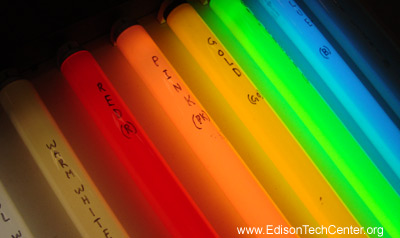 |
Pioneers: George Inman and Richared Thayer
R& D Engineers: William L. Enfield and Philip P. Pritchard
Application Engineer: Ward Harrison
OF NOTE: In January 1931 (Jan 27, '31 to be exact) Dr. Albert W. Hull of the GE Schenectady labs, obtains a paten for low pressure vapor-discharge lamps - this is a big step towards the development of fluorescent lamps in coming years
1934: Dr. Arthur H. Compton, on a visit to Oxford, England writes a letter to Dr. William L. Enfield telling him of the English lamp makers showed him an interese4ting experimental lamp. It was tubular, about 2 feet long, and the center portion was coated with fluorescent material. It emitted a yellowish-green light, and appeared to be highly efficient.
In November 1934 research begins at NELA Park. Under management of Dr. William Enfield, George Inman started development work. Also in the group were Richard Thayer, Eugene Lemmers, Dr. Willard A. Roberts. In December, the group made their first lamp. It was 10 inches long, ¾ inch in diameter, and had an electrode in each end. The group made lamps that used various phosphors, including zinc silicate.
1934-35: Dr. Clifton G. Found joins the R and D Group. Dr. Willard Roberts, a chemist develops phosphors - aided by Dr. G.R. Fonda and C. A. Nickel of Schenectady, and Harry M. Fernberdger of the Wire Division. In the first few years of fluorescent lamp production the most important phosphors were zinc-beryllium silicate and magnesium tungstate ("white" and "daylight" lamps, respectively).
In July 1935, Lamp department engineers and research men held a closed meeting at NELA Park with a group of U.S. Navy officers. Sample fluorescent lamps were displayed, and the Navy men were the first persons outside GE to see the new lamps. In early September 1935 the illuminating engineering society (I.E.S.) held its annual convention oat Cincinnati, Ohio. GE's exhibit booth showed one of the new "F" lamps in operation. The lighting engineers attending were interested, but not overwhelmingly impressed. The lamp looked like a highly specialized item. It was 2 ft long, produced a brilliant green light. A display card read: "The fluorescent lumiline lamp - a laboratory development of great promise." This statement on that card was a REAL UNDERSTATEMENT - INDEED, for in only about 6 years, a war and a new light source will transform the USA and soon the World!
1936-1937: In July, 1936 machinery to produce fluorescent lamps is beginning development with Philip J. Pritchard in charge. Meanwhile other departments of GE aided in construction of ballasts, starters (incorporated in the same case as the ballast at first), and lamp sockets for F lamps. The Transformer Engineering Department in Fort Wayne, Indiana develops ballasts.
On November 23, 1936, a dinner held in Washington DC celebrating the 100th anniversary of the founding of the U.S. Patent Office was doubly historic. The guests attending the dinner were seeing for the first time a practical public application of fluorescent lighting. The new lamps, furnished by GE, provided much of the lighting in the large banquet hall.
More than a year passed, it was late 1937, and P.J. Pritchard and his colleagues were making progress, but no factory could take on fluorescent lamp production yet. Very soon this would change!
1938: On April 21, 1938, GE announced the introduction of fluorescent MAZDA lamps as a regular line and they were placed on public sale. A story in the Magazine of light appeared at the same time stating that "These new light sources provide colored light at efficiencies therefore unobtainable." Lighting would be changed forever, and for the better!
1938: The new MAZDA 'F' lamps are available in 3 sizes as follows: 15 W, 18 inches long, 1 in. in diameter ('T-12'), and 30 W, 36 inches long, 1 in. in diameter ('T-8'). They come in 7 colors, 2 of which are "whites".
The colors are as follows: Red, Gold (yellow), Green, Blue, Pink, White (3500 deg. K), and Daylight (6500 K). 3 types of "auxiliaries" or ballasts, to operate F lamps were available in 1938. The "magnetic Auxiliary" ballast, which was simple choke reactor type ballast combined with a "doorbell buzzer-magnetic 'vibrator'-relay starter unit" in the same case. The next type of ballast was the "Thermal Auxiliary" which walls had a choke reactor type ballast combined with a "doorbell buzzer-magnetic 'vibrator'-relay starter unit" in the same case.The next type of ballast was the "Thermal Auxiliary" which also had a choke-reactor ballast combined with a thermal-switch-relay starter unit in the same case. The last type, still made today, was then called a "Manual Start Auxiliary" and was merely a choke ballast for use with manual starting switches. The 15 and 20 W ballasts were 110 to 120 volts. The 30 W ballasts were 220-240 volts, and required step-up transformers installed in the fixtures if the 220 volts needed was not supplied and only 110 volts was available to the fixtures.
In the summer of 1938, Westinghouse Electric Corporation invents the glow-switch type of starter. Initially in an S-6 bulb with bayonet base, it fit into a socket on the end of the ballast case. The familiar "can" twist -in glow switch starter didn't appear until mid-summer 1939.
1938: A little later in this year, the 14 W, 15 inch 1-1/2" (T-12) MAZDA lamp is introduced. Initially intended for use on a 64-volt street rail car, it soon was used 2 in series on 120 volts with a 60 volt ½ amp incandescent MAZDA lamp as a ballast, in floor and table lamps, it also operated on 15 watt ballasts as well.
Germicidal lamps ware introduced. Clear, with no phosphors, and made of U.V. transmitting "corex-D" glass, they emit short-wave ultraviolet (U.V.) rays that kill airborne bacteria. The lamp was made in 15 W and 30 W T-8 tubes then. Westinghouse developed the principals prior to 1936.
In late spring of 1938, fluorescent lamps were shown at the New York World's Fair and the Golden Gate Exposition in San Francisco, CA. The lamps were used outdoors at the world's fairs and a large indoor installation at the New York Exposition.
Fluorescent lighting was now officially launched. In October 1941 a patent was granted to George Inman covering the basic principals of fluorescent lamp design. The application was filed in April 1936.
During 1938 form April on, GE and the whole industry sold about 200,000 lamps, good for the first year, but nothing compared with what was soon to come!
1939:
The 40 W lamp (white color) was rated at 35 lumens per watt early on, and before mid-year it had reached 47 lumens per watt(lpw), and by years end it reached 50 lpw.
Sales of fluorescent lamps rocketed to 1.6 million in 1939.
GE develops the RF, or Rectified Fluorescent lamp for industrial lighting early in the year. It was 8.5 watts, 58 inches long, 1-1/4 inches in diameter (T-10), and was 47 lpw and rated at 3000 hours. It had one heated cathode at one end, like standard F lamps, and 2 unheated anodes at the other end. Current flowed in only one direction, thought the lamp, going to the 2 anodes alternately as the A.C. line current changed direction 60 times a second (120 reversals/sec.) making the RF lamp a "full-wave mercury-arc rectifier." It used special bases and sockets, with 3 prongs on the anode end, 2 prongs on the cathode end, and special ballast. It needed no starter either. It was not made after 1942 anymore.
Hygrade -Sylvania develops "stroboscopic-corrected" lead-lag ballast circuits, and introduces the first fixture to use it - the 2-lamp, 4 ft "HF-100" unit for industrial use. This had 2 choke ballasts, a step-up transformer, a starting compensator for the "leading" lamp, and a capacitor for this same compensator for the "leading" lamp, and a capacitor for this same lamp, all separate units! I have one, made circa May 1939, serial no. 8108 with rare original thermal-switch starters - working!
1939: Early in this year (around Feb-March) GE introduced the now ubiquitous 48 inch (4 ft) 1-1/2 in. Diameter T-12, 40 watt MAZDA F lamp. Initially there was much skepticism among GE engineers that such a long lamp was not practical or even possible to manufacture. Again GE accomplished the "impossible"! Like the 30 watt lamp, this new lamp at first used 240 volt choke ballast and a step-up transformer if used on a 120 v circuit. This size quickly became and remains to this day, the most popular fluorescent lamp ever made! Even today's 4 foot T-8 F lamps aren't at all "high tech" and were made experimentally in 1939!
This article goes on in depth until 1957. See the full article at the Edison Tech Center.Video featuring the earlier inventors of the lamp:
Click on the graphic below to see our full page on fluorescent lamps including early history.
TO READ MORE: visit our lighting display where this is displayed.
Related Topics:
Go back to the Engineering Forum
Submit your article for consideration via email to info at edisontechcenter.org
Criteria for submission: Articles may only be submitted by ETC Donors. ETC Donors have paid 25 USD minimum per year. Articles will be reviewed before publication. No profanity or crass language is permitted. Works must appear to be complete and must be the full work of the author. When the author submits the work he/she is stating that they are the true author and give the limited right of internet publication to the Edison Tech Center. This tool is meant to discuss historical/general engineering topics and/or give publicity to you're work or projects.
Photo/Video use:
Commercial entities must pay for use of photos/graphics/videos in their web pages/videos/publications
No one commercial or public is allow to alter Edison Tech Center photos/graphics/videos.
Educational Use: Students and teachers may use photos and videos for school. Graphics and photos must retain the Edison Tech Center watermark or captions and remain unmanipulated except for sizing.Permissions - Videos: We do not email, FTP, or send videos/graphics to anyone except in DVD form. Payment is needed for this service. See our donate page for pricing, and our catalogue for a listing of videos on DVD.
Professional video production companies may get videos in data form with signed license agreements and payment at commercial rates.
Volunteer - About Us - Resources - Videos - Engineering Hall of Fame - Donate - Contact Us
